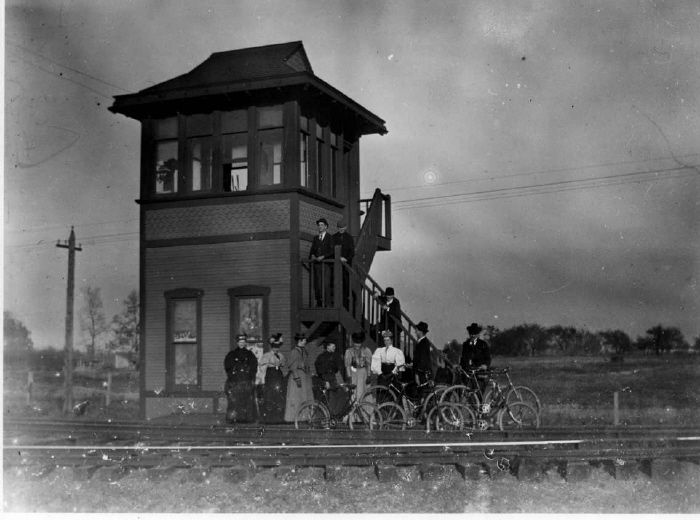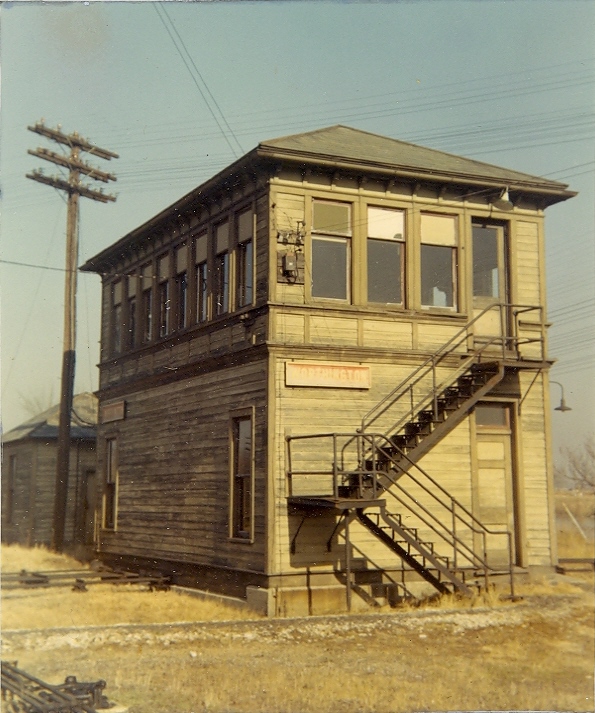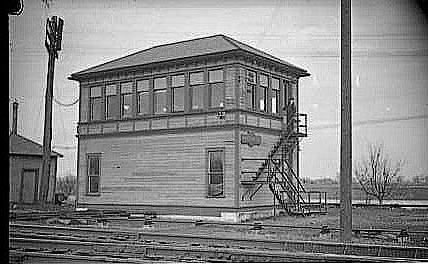Worthington Interlocking Tower
Big Four (NYC) / Sandusky Branch (PRR) Crossing
Introduction
In 1851 the first railroad was
built through Worthington. It was called the Cleveland Columbus &
Cincinnati Railroad although it would be over ten years before it reached
Cincinnati. By 1889 further railroad consolidations would change its
name to the Cleveland Columbus Cincinnati and St Louis (C.C.C. & St. L)
better know as the "Big Four Route". In the twentieth Century the
Big Four would become a part of the New York Central System (NYC).
In the 1950's even though the equipment and buildings were labeled New
York Central, to the fans and railroad workers it was still called the Big
Four. The Big Four through Worthington
was always a single track railroad. There was a depot just north of SR 161.
To learn more about the Big Four click here.
Things became interesting when
in 1893 a second railroad was built through Worthington, the Sandusky &
Columbus Short Line (S&CSL). Its right-of-way paralleled the Big Four from
Delaware to Columbus. When it left Delaware it was on the west side
of the Big Four, but when it got to Columbus in needed to be on the east side. The S&CSL made the cross over at Worthington just
south of SR 161. The S&CSL was the junior railroad which meant it
covered all the costs of the crossing and paid for the tower staffing. In
1902, after consolidation and bankruptcy, the Sandusky - Columbus section
of the then Columbus Sandusky & Hocking Line
was purchased by the Pennsylvania and Detroit Railroad thus becoming part
of the Pennsylvania Railroad. This line was referred to as the
Pennsylvania Railroad's Sandusky Branch. The Sandusky Branch was
built as a single track railroad through Worthington, although that would
change. There was a depot and a freight house on the north side of
SR 161 and a tower controlling the crossing just south of SR 161.

This is the first Worthington tower built in 1893. It
lasted until the Sandusky Branch was double tracked. Bicycle riding was a hot
(literally) new activity in the 1890's. Here a touring group was
visiting the tower. If they came from central Worthington they would
have ridden over what is now SR 161, but then a dirt road.
Through the open window can be seen some of the levers for changing the
switches. Communication would have been by telegraph. In the
bottom half of the right hand first-floor window, behind the women's shoulder, can be
seen a poster for the Ohio State Fair. The camera is pointed east.
The track closest to the photographer with the sun reflecting off the rail
is the S&CSL. Photo from the DAK collection.

The second Worthington tower was
built when the Sandusky Branch was double tracked sometime around 1916.
The first floor of the tower is the equipment
room holding the switch and communications gear. The operator worked
on the second floor. The little building on the left holds the
furnace and coal supply for the furnace.
This tower had to be larger then the first
tower because now the operator controlled two diamonds, one for each Sandusky Branch track
crossing the Big Four. There were also crossovers from Sandusky
Branch track one to track two on both sides of the diamonds. These
allowed a train, that was on a track opposing the flow of traffic, to change over to the
correct track. The tower had levers to control the Sandusky Branch
signals and derails. A passing siding for the Big Four and
the signals for the Big Four were controlled by electrical switches.
Photo by Ryan Hoover in 1956.

This photo taken by Don O'Brien in the winter of 1937-38 is the earliest photo I have of tower #2. The
tower looks like it still has some paint on it and the "Worthington" sign
is a little fancier than the 1956 photos. You can see how the tower foundation
on the track facing side of the building is notched out to allow the
pipes that connect the switches to the levers to exit the building. Poste lake behind the tower is visible. Since the late 1940's Poste
lake has been surrounded by houses and now tall trees making for a total
different view.
Don O'Brien grew up in Worthington in the
1930-40's becoming a professional photographer. You can see more of
his excellent photos of Worthington by
clicking here.
Next


